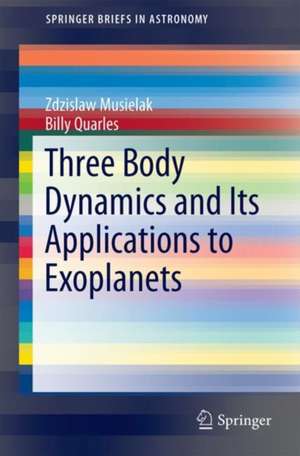Three Body Dynamics and Its Applications to Exoplanets: SpringerBriefs in Astronomy
Autor Zdzislaw Musielak, Billy Quarlesen Limba Engleză Paperback – 28 iul 2017
Din seria SpringerBriefs in Astronomy
-
 Preț: 313.82 lei
Preț: 313.82 lei -
 Preț: 381.98 lei
Preț: 381.98 lei -
 Preț: 377.18 lei
Preț: 377.18 lei -
 Preț: 378.12 lei
Preț: 378.12 lei -
 Preț: 379.09 lei
Preț: 379.09 lei -
 Preț: 443.97 lei
Preț: 443.97 lei -
 Preț: 375.62 lei
Preț: 375.62 lei -
 Preț: 378.12 lei
Preț: 378.12 lei -
 Preț: 380.07 lei
Preț: 380.07 lei -
 Preț: 375.07 lei
Preț: 375.07 lei -
 Preț: 381.00 lei
Preț: 381.00 lei -
 Preț: 377.18 lei
Preț: 377.18 lei -
 Preț: 377.35 lei
Preț: 377.35 lei -
 Preț: 376.04 lei
Preț: 376.04 lei -
 Preț: 338.70 lei
Preț: 338.70 lei -
 Preț: 409.43 lei
Preț: 409.43 lei -
 Preț: 444.94 lei
Preț: 444.94 lei -
 Preț: 412.30 lei
Preț: 412.30 lei -
 Preț: 375.62 lei
Preț: 375.62 lei -
 Preț: 442.02 lei
Preț: 442.02 lei -
 Preț: 445.49 lei
Preț: 445.49 lei -
 Preț: 376.22 lei
Preț: 376.22 lei
Preț: 411.16 lei
Nou
Puncte Express: 617
Preț estimativ în valută:
78.71€ • 82.13$ • 65.98£
78.71€ • 82.13$ • 65.98£
Carte tipărită la comandă
Livrare economică 12-26 martie
Preluare comenzi: 021 569.72.76
Specificații
ISBN-13: 9783319582252
ISBN-10: 3319582259
Pagini: 108
Ilustrații: VIII, 109 p. 26 illus., 21 illus. in color.
Dimensiuni: 155 x 235 x 10 mm
Greutate: 0.18 kg
Ediția:1st ed. 2017
Editura: Springer International Publishing
Colecția Springer
Seria SpringerBriefs in Astronomy
Locul publicării:Cham, Switzerland
ISBN-10: 3319582259
Pagini: 108
Ilustrații: VIII, 109 p. 26 illus., 21 illus. in color.
Dimensiuni: 155 x 235 x 10 mm
Greutate: 0.18 kg
Ediția:1st ed. 2017
Editura: Springer International Publishing
Colecția Springer
Seria SpringerBriefs in Astronomy
Locul publicării:Cham, Switzerland
Cuprins
1.Introduction.- 2.Basic Formulation.- 3.Theoretical Developments.- 4.Numerical solutions.- 5.Astronomical Applications.- 6.Beyond the Three-Body Problem.- 7.Summary and Concluding Remarks.
Notă biografică
Professor Zdzislaw E. Musielak is currently Professor of Physics at the University of Texas in Arlington. He has taught classes in all areas of physics to undergraduate and graduate physics students since 1982. Dr. Musielak’s research has focused on physical processes in solar and stellar atmospheres, orbital stability of extra-solar planets, searches for exomoons, theory of chaos and nonlinear dynamical systems, and developing new methods in mathematical physics. He has published more than 200 papers in national and international physics and mathematical journals, and is the recipient of many research awards, including Humboldt Prize.
Dr. Billy L. Quarles is currently a Postdoctoral Research Associate at the University of Oklahoma in Norman. He has been an active player in the field of exoplanets over the last 5 years. As a graduate student, he specifically developed a stability criterion for the three-body problem using the Lyapunov exponent. Asa NASA postdoctoral fellow, he has investigated the stability of many body systems to infer possible conditions on their origins. Along with collaborators, Dr. Quarles has aided in the discovery of the first Earth-sized extrasolar planet orbiting within the habitable zone of its host star and the tenth extrasolar planet to orbit two stars. As an early scientist, he has collaborated internationally within the Kepler mission and helped develop the most recent catalogs of planetary candidates.
Dr. Billy L. Quarles is currently a Postdoctoral Research Associate at the University of Oklahoma in Norman. He has been an active player in the field of exoplanets over the last 5 years. As a graduate student, he specifically developed a stability criterion for the three-body problem using the Lyapunov exponent. Asa NASA postdoctoral fellow, he has investigated the stability of many body systems to infer possible conditions on their origins. Along with collaborators, Dr. Quarles has aided in the discovery of the first Earth-sized extrasolar planet orbiting within the habitable zone of its host star and the tenth extrasolar planet to orbit two stars. As an early scientist, he has collaborated internationally within the Kepler mission and helped develop the most recent catalogs of planetary candidates.
Textul de pe ultima copertă
This brief book provides an overview of the gravitational orbital evolution of few-body systems, in particular those consisting of three bodies. The authors present the historical context that begins with the origin of the problem as defined by Newton, which was followed up by Euler, Lagrange, Laplace, and many others. Additionally, they consider the modern works from the 20th and 21st centuries that describe the development of powerful analytical methods by Poincare and others. The development of numerical tools, including modern symplectic methods, are presented as they pertain to the identification of short-term chaos and long term integrations of the orbits of many astronomical architectures such as stellar triples, planets in binaries, and single stars that host multiple exoplanets. The book includes some of the latest discoveries from the Kepler and now K2 missions, as well as applications to exoplanets discovered via the radial velocity method. Specifically, the authors give a unique perspective in relation to the discovery of planets in binary star systems and the current search for extrasolar moons.
Caracteristici
Uniquely combines the historically developed methods to solve the three-body problem with the most current developments in the field of orbital mechanics, driven by the recent discoveries of exoplanets and exoplanetary systems Provides significant updates to the current literature through the inclusion of Kepler discoveries (Kepler-36, Kepler-16, Kepler-47) Gives graduate students and researchers a solid background in the field that will allow them to solve advanced problems that arise every day in the rapidly changing field of exoplanets
